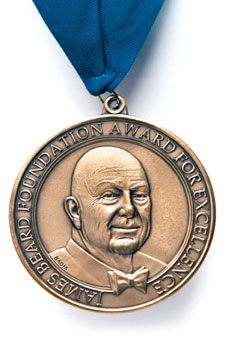 Every month or so I look forward to receiving the "events publication" from the James Beard House in New York City. Part booklet, part magazine, not only is it a gastronomic "look-see" into the minds of chefs and what they're thinking, but also a good indication of what may be cropping up on menus in your own zip code. Keeping in mind that cooking at the Beard House requires a certain amount of performance art and culinary high-wire acts, the offerings are complex and sometimes over-the-top. Yet, I'm fascinated by the ingredients I've never heard of (yes, I just admitted that), grateful for a new technique or idea, and sometimes baffled by some of the crazy-mixed up combinations.
Every month or so I look forward to receiving the "events publication" from the James Beard House in New York City. Part booklet, part magazine, not only is it a gastronomic "look-see" into the minds of chefs and what they're thinking, but also a good indication of what may be cropping up on menus in your own zip code. Keeping in mind that cooking at the Beard House requires a certain amount of performance art and culinary high-wire acts, the offerings are complex and sometimes over-the-top. Yet, I'm fascinated by the ingredients I've never heard of (yes, I just admitted that), grateful for a new technique or idea, and sometimes baffled by some of the crazy-mixed up combinations.
Nonetheless, a read of the menus to be cooked by myriad chefs from all over the country provides an "instagram" sweep of America's culinary landscape. There's almost a dinner every day at the Beard House, with chefs telling their stories through the narrative of the menu, somewhere in the USA.
First, the ingredients: You'll be seeing mutton, geoduck, banana leaves, lamb tongues, mantequilla enojada (I must look this up), beef heart, gizzards, lotus leaf, finger limes, lotus root, barberries, nettles, cara cara oranges, red verjus, headcheese, shimeji mushrooms, green strawberries, buttermilk, sugar cane, scrapple, lamb neck.
A few new ideas: There's "lambcetta" (I imagine that's a riff on pancetta but who knows), white barbecue sauce, cold fried chicken torchon, cider aspic, black sesame panna cotta with yuzu, sweet chestnut-filled ravioli with warm English custard, brisket bourguignon (with lamb belly confit and quinoa).
Some nice menu language: Foraged mushrooms of the moment, fresh-churned butter, Chocolate Study=Soft, Crunchy, and Nutty.
Most curious? Coffee malt crème and soda bread parfait with frozen parsnips.
I am struck by the lack of cheese in the dishes or their presence on the menus. Instead most menus were chock-full of mystery words and only a handful showed a kind of elegant restraint. It was refreshing to see the word "fumet."
What does it all mean? Some of the wanton (not wonton!) creativity that began in the 1970s was expressed on menus in language that read like shopping lists, where every ingredient in a dish was revealed. The trend continues today. And while it is a way for chefs to differentiate themselves from others, the menus have a sense of gastronomic sameness -- with little sense of place, identity or ethnicity. This is merely an observation and not a judgment for it is what we have come to expect of our chefs and their menus. "Wow me," we say. And for the most part, this is what the chefs are doing. Frozen parsnips, anyone?
If you're lucky enough to be in New York in March or April, or anytime really, you should try one of the Beard House dinners. You'll be dropping into a wondrous food community and share a bit of the past... and the future.

